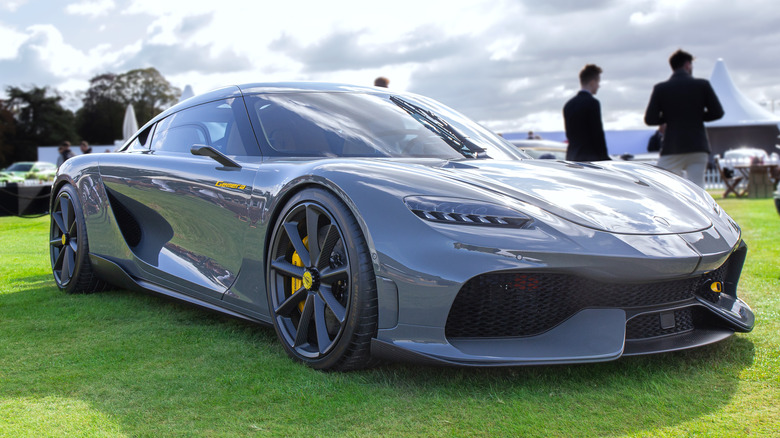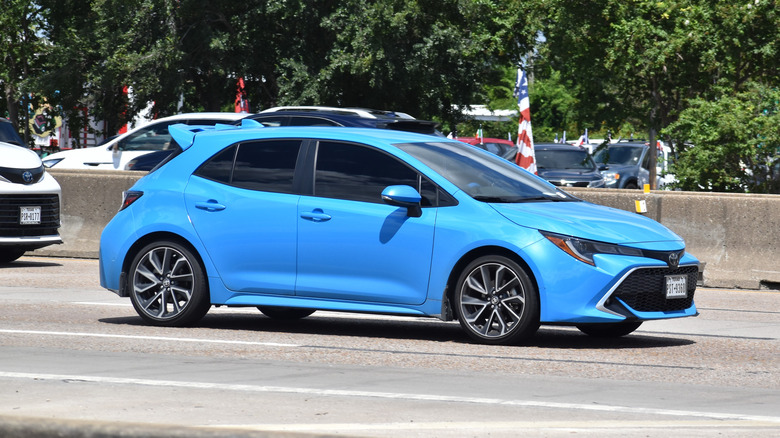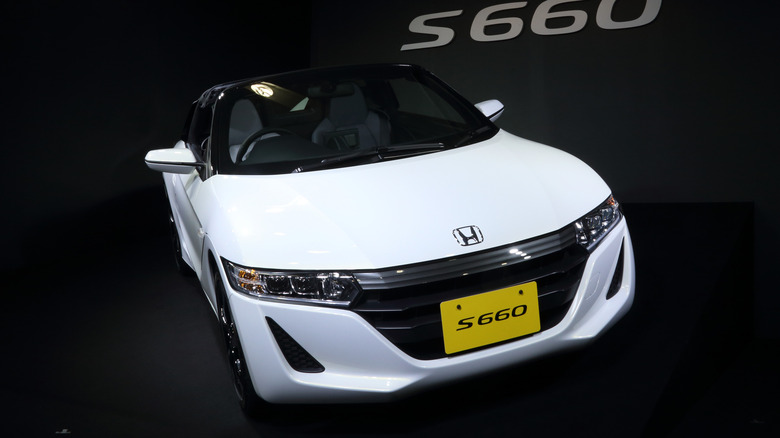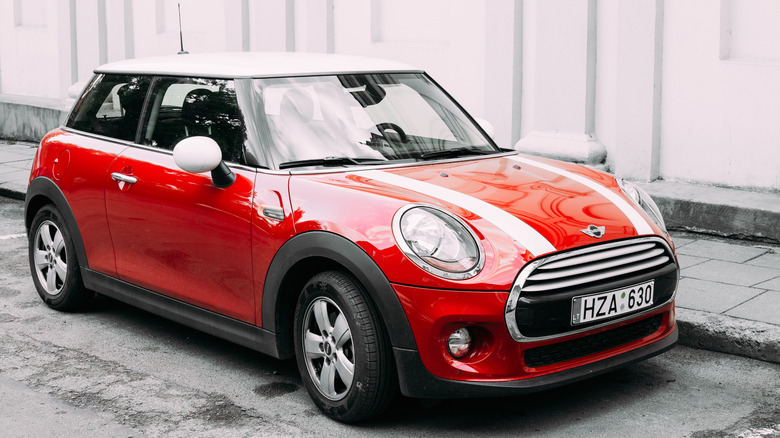When most people think of a fast car, they think of one powered by a V8, V10, or V12 engine. But it’s not always the bigger, the better. Having more cylinders is not always optimal. It also isn’t very cost-efficient. It may surprise some that 3-cylinder vehicles can still pack a punch even when compared to hypercars that hit unheard-of speeds — and some hypercars even have 3-cylinder engines.
There are a few benefits that can come from a 3-cylinder engine. For one, they are generally lighter than other engines. This can bring down the overall weight of a vehicle, leading to better handling and speed. Although a lightweight 3-cylinder car probably won’t win in a drag race, it can feel very fast on winding roads and narrow streets.
They also tend to be more fuel-efficient. For those who want to go fast but remain conscious of their impact on the planet, 3-cylinders are a solid choice because they often have lower emissions. These 3-cylinder vehicles prove that less power doesn’t have to mean less speed.
Koenigsegg Gemera

Martyn Lucy/Getty Images
The Koenigsegg Gemera is one of the fastest 3-cylinder vehicles around. Powering the hypercar is the Koenigsegg Tiny Friendly Giant Twin Turbo Freevalve 3-cylinder combustion engine that produces 600 horsepower at 7,500 rpm. The car red lines at 8,500 rpm and pumps out 442.8 lb-ft. of torque from 2,000 rpm to 7,000 rpm. Notably, this vehicle doesn’t have a traditional camshaft. Instead, it sports freevalve camless technology for controlling each individual valve for improved performance. It also features Koenigsegg Electronic Stability Control (KES) and three traction control settings: normal, wet, and track. Another crucial aspect of this vehicle is that it is not solely reliant on the 3-cylinder engine.
The Koenigsegg Gamera is a hybrid powertrain with three electronic motors alongside the 3-cylinder engine. There’s one for both back wheels and one integrated into the engine on the crankshaft for the front axle. Combining the power of these engines gives the vehicle a total output of 1,700 horsepower and 2,583 lb-ft. of torque. The Koenigsegg Gamera can go from 0 to 62mph in 1.9 seconds and achieve a top speed of 248 mph.
The car’s exterior includes rear aluminum sub-frames alongside carbon fiber body panels and monocoque chassis. The wheelbase is 118.11 inches. At the front are 21 x 10.5-inch wheels, while the back sports 22 x 11.5-inch wheels. If you want one and have $1.7 million to spare, you may still be out of luck. Only 300 of these unique four-door hypercars were manufactured.
Ford Fiesta ST
The Ford Fiesta ST is a high-performance variant of the Fiesta produced between 2018 and 2023, and one that offers a very different driving experience. For a 3-cylinder hot-hatch, its achievements are nothing to scoff at. It can go 0-62 mph in 6.5 seconds and has a top speed of 143 mph.
It gets its speed from its 1.5-liter turbocharged 3-cylinder engine that pumps out 197 horsepower at 6,000 rpm and 214 lb-ft. of torque at 1,600-4,000 rpm. The engine, paired with its 2,742 lb. base curb weight, allows it to be maneuverable and sporty. Like many hatchbacks, this one is a front-wheel drive vehicle and features a 6-speed manual gearbox. The Fiesta ST also has something for environmentally conscious individuals: cylinder deactivation. This lets the vehicle disable a cylinder’s fuel delivery and valve operation when not needed. The process happens in 14 milliseconds, so there is no noticeable loss of power.
For those who like to live daringly, there is a track mode to disable traction mode and squeeze out a little more fun from the car. When you do need to bring the car to a halt, there’s also Torque Vectoring Control for individual braking to the front wheels.
BMW i8
In 2017, the BMW i8 — sporting its gas and electric engines — was a true 21st Century Supercar. The gas engine is a 1.5L BMW TwinPower Turbo 3-cylinder accompanied by a 6-speed automatic transmission. The engine outputs 228 horsepower and 236 lb-ft. of torque to the rear wheels. Pushing power to the front wheels is a 96-kW electric motor for 131 horsepower and 184 lb-ft. of torque. Combining the engines, the BMW i8 has a total output of 369 horsepower and 420 lb-ft. of torque. Harnessing the power of all the engines lets the BMW i8 do 0-60 in 4.2 seconds and reach a top speed of 155 mph.
The vehicle also boasts features that give drivers more options. For example, switching modes allow you to run the vehicle with just the electric engines or incorporate the 3-cylinder engine for all-wheel-drive. Notably, the vehicle has its battery mounted low to the ground to give it a better center of gravity.
The battery, an 11.6 kWh high-voltage lithium-ion pack, can be charged in 3.1 hours. With all the engines working together, the BMW i8 has a total range of 330 miles and achieves 69 MPGe. The BMW i8 launched in 2017 with a $144,395 sticker price. Today, the BMW i8 line still exists. However, the 2026 model is expected to replace the 3-cylinder with a turbocharged 4-cylinder engine.
Toyota GR Corolla

Artistic Operations/Getty Images
The Toyota GR Corolla is a hot hatch with a 3-cylinder engine. It sports a G16E-GTS 1.6L turbocharged 3-cylinder engine that pumps out 300 horsepower and 273 lb-ft. of torque. The engine gives the car a 0-60 time of 4.99 and a top speed of 142.9 mph. Accompanying the engine is a 6-speed manual transmission and an all-wheel drive drivetrain. The all-wheel-drive setup is a blast, making the car a daily love affair. The tuning allowed the car to be suitable for taking a casual drive to the store or speeding down a winding road.
The vehicle’s curb weight is 3,252 lbs, which lets the engine do its work. From the look of the GR Carolla, you can guess that the World Rally Championship inspired it. It has a triple-brushed stainless-steel exhaust, a rear lip spoiler, and chunky fender flares. Additionally, it has a GR circuit-tuned suspension.
18-inch, 15-spoke alloy wheels come standard on the car. Because it is an all-wheel-drive vehicle, 60% of the power goes to the front wheel and 40% to the rear. Switching to track mode can adjust this to 50/50 power distribution. You can pick up a 2024 model starting at $36,500.
Honda S660

Bloomberg/Getty Images
The Honda S660, debuting in 2015, is one of the best Honda sports cars ever made. It gets its name from its 660-cc 3-cylinder turbo engine. The engine produces 64 horsepower and 77 lb-ft with its multi-point turbocharged injection of torque 7,700rpm. With those numbers, you can’t expect it to excel on the drag strip. It does, however, have a top speed of 87 mph.
This rear-wheel drive two-door car has a 6-speed manual transmission and a convertible body style. Most notably, it only weighs 1,830 lbs. This makes sense when you take into account the 64 horsepower. The car was designed as an economical small car that can be used as a daily driver. But it wasn’t designed for the U.S.
The car was manufactured for the Japanese market as a mini-car, or Kei car. These vehicles must abide by strict regulations. They can’t exceed a length of 3.4 meters (11.15 feet), width of 1.48 meters (4.86 feet), and height of 2 meters (6.56 feet). It also can’t have an engine larger than 660cc. Although it isn’t blazingly fast, the car has become a cult classic in recent years. The mid-engine car is often taken on tight, winding roads. Its small size makes it a fun vehicle to drive at relatively slow speeds.
Mini Cooper

Bruev/Getty Images
The two-door Mini Cooper hardtop is many people’s first introduction to 3-cylinder vehicles. The 2024 hardtop version can be picked up for $25,800, making it more affordable than others on this list. Powering the Cooper is a TwinPower Turbo 1.5-liter, inline 3-cylinder direct-injection engine that pumps out 134 horsepower at 4,500 rpm and 162 lb-ft of torque at 1,480 rpm.
The engine features BMW’s double VANOS system. VANOS adjusts when the exhaust and intake valves open based on the engine’s RPM, temperature, and load. This helps increase engine performance and torque. With its 3-cylinder engine, the two-door hardtop Cooper can go 0-60 in 7.5 seconds. This is partly thanks to its weight of 2,711 lbs. Speed isn’t everything, though. Like most Cooper’s, many find the 3-cylinder hardtop’s suspension and responsive steering make for nimble handling. Although you won’t break any speed records, the front-wheel-drive car can feel faster than it is because of those factors.
Caterham Seven 160
The Caterham Seven 160 is not your everyday automobile. It’s for the hobbyist who wants to build their own unique vehicle. Once put together, the Seven 160 uses its turbocharged 660cc Suzuki 3-cylinder with a direct injection fuel system to get around the track. This essentially makes it a Kei car, just like the Hondo S660.
Its engine produces 80 horsepower at 7,000 rpm. A 5-speed manual gearbox and independent front and rear suspension complement the engine. The vehicle weighs 1,080 lbs with its aluminum body, making it the lightest on this list. Its lightweight build can achieve 0-60 in 6.5 seconds and a top speed of 100 mph. With its not-so-grippy 14-inch steel wheels tires, many find the car more fun to drive than modern standard vehicles. The Caterham 7 was launched as a successor to the Series 3 Lotus Seven, designed by the legendary engineer, designer, and founder of Lotus Cars, Colin Chapman. These vehicles don’t have all the bells and whistles of a normal car. It’s made for those who want no distractions between themselves, the machine, and the road.
Volkswagen Up GTI
The Volkswagen Up GTI is a sporty variant of the compact VW Up city car. To give it a little extra oomph and set it apart from the base model, the GTI has a 3-cylinder inline Volkswagen GTI 1.0 TSI engine with a direct injection fuel system that Produces 115 horsepower and 147.5 lb.-ft. of torque at 2,000 to 3,500 rpm. This is paired with a 6-gear manual transmission.
Not much changed with the exterior of the Up GTI after giving it more power. It still sports the car’s length at 141.7 inches, width at 64.6 inches, and height at 58.2 inches, with a resulting curb weight of 2,400 lb. Despite its size, this front-wheel-drive car still features four doors and can seat four passengers.
Its small build paired with its 3-cylinder engine allows it to go 0-60 in 8.8 seconds with a top speed of 122mph. The standard Up understandably cannot compete with the Up GTI’s speed with its 60 horsepower engine. Unfortunately for fans of this pint-sized vehicle, production ended in 2023.
Karma GS-6
The Karma GS-6 is a unique-looking sedan. SlashGear tested the 2021 Karma GS-6 when it debuted and was impressed by many of its offerings. One of its defining features is its 1.5L turbocharged inline-3 engine from BMW. This is the same engine featured in the BMW i8. That said, the engine functions simply as a range extender. The onboard electric engines are what put in the real work.
This vehicle has a twin-motor electric configuration on the rear axle. The rear-wheel-drive car produces 536 horsepower and 550 lb-ft of torque. A single-ratio direct-drive automatic transmission compliments the engine. Putting the pedal to the metal will get you from a standstill to 60 mph in 4.5 seconds. While doing so, you are treated to some sci-fi spaceship sounds rather than traditional gas engine noise.
Powering the electronic engines is a 28 KWh battery that is rated for 80 miles. When the Karma GS-6 first hit the road, it retailed for $83,900 before EV incentives were applied. A 2022 model was later produced, but the only real change was that it didn’t offer the base trim.At a curb weight of 5,095 lb, the Karma GS-6 is by no means the lightest car on the list. But with a 3-cylinder engine and some electric engines to boot, it’s still fun to drive with its solid steering and braking.